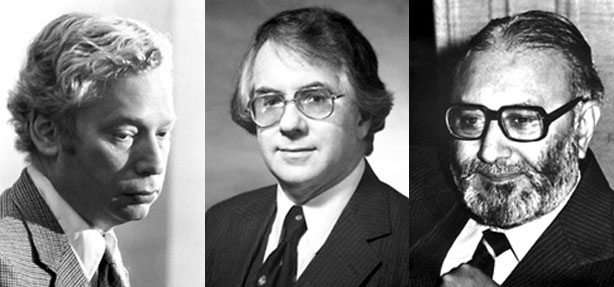This is a part of a short talk that I am giving to the Osher Lifelong Learning Institute at UC Irvine on the LHC update.
The discovery of the Higgs Boson, postulated by Peter Higgs and others in 1964, is important not just as the missing final particle of the standard model, but because establishes many basic concepts of particle physics, and points the way to new questions. Here is but an outline of its importance.
The Higgs Boson is a spinless or scalar excitation of the Higgs field. Unlike the field of any other particle discovered to date, it is present in empty space with a constant value (vacuum expectation value) everywhere and at all time. It gives mass to the fundamental quarks and charged leptons (electron, muon, tau), but not their neutrinos. Maybe this is why it was called in jest the “God particle”, since it is present everywhere and interacting with matter at all times.
The theory of quarks and leptons and the unification of the weak interactions with the electromagnetic ones proceeds according to symmetries that required that all particles started as massless ones. The accomplishment of this by Steven Weinberg and Abdus Salam was done in 1967. Along with Sheldon Glashow, they were awarded the Nobel Prize in Physics in 1979 for this. This is a photo set of the physicists in the years they did their research on this: from left to right Weinberg, Glashow, and Salam.
The vector bosons (spin one particles) that are involved in the weak interactions are the W plus and minus charged bosons and the neutral Z boson. The electromagnetic interaction is via the well known massless photon boson. For a starting point, the bosons must be in complete sets of particles under the weak isospin symmetry, which is a symmetry of rotating in an abstract isospin space exactly analogous to spin symmetry in ordinary space.
Left handed quarks and leptons pair off to form weak isospin 1/2 doublets, which have only weak isospin 1/2 up and weak isospin -1/2 down states, analogous to spin up and spin down states in ordinary space for spin 1/2 particles which are called fermions.
The interaction bosons must also belong to multiplets, and the charged W’s and a neutral W must form an isospin 1 multiplet, with weak isospin alignments of +1, 0, and -1, analogous to a spin 1 boson in ordinary space having angular momentum along an axis of +1, 0, and -1. The fourth electroweak boson must be a lone singlet under weak isospin and is called the neutral B boson.
When this perfect symmetry is broken to give the real world of massive quarks, leptons, and electroweak bosons, the Higgs coupling to each of the quarks and leptons must be specified to be exactly proportional to the mass of each of these, and when the Higgs field is replaced by its vacuum expectation value v, must give the mass of each quark and lepton. The other or excitable part of the Higgs field, usually called phi, then couples to each quark and lepton proportional to their mass.
The way to give masses to the W plus and minus and neutral Z, while leaving the photon massless requires three new degrees of freedom for their spin zero components, which massive bosons have, but massless bosons do not have. This is accomplished by having four Higgs components, two of which are charged, for the charged Ws, and two of which are neutral. This is accomplished by making the Higgs a weak isospin doublet with positive and zero charge components. Its antiparticle field has the negative and zero charge components. The neutral components mix, and one becomes the one with the vacuum expectation value v and the observed excitation phi, and the other neutral one becomes the third spatial component of the neutral Z particle.
Well, this is a lot more detailed than I meant to say, which is that there is a symmetry under which all particles are massless, and that the Higgs “mechanism”, breaks the symmetry, gives a non-empty vacuum, provides mass to all quarks, charged leptons, and weak bosons, and interacts with them proportional to their masses.

